Sciberia Lungs
0. About the Product
Sciberia Lungs is software for automated analysis of medical images from computed tomography of the lungs. The goal of the processing is the automatic detection of infiltrative and interstitial changes, assessment of the volume of these changes in patients suspected of viral pneumonia, particularly associated with COVID-19 (hereinafter referred to as the module, software).
Note
Sciberia Lungs is a Clinical Decision Support System (CDSS).
0.1. Functionality
Software Functional Characteristics:
The software assists the doctor in making an accurate diagnosis and deciding on further treatment.
It can automatically process incoming CT images of the chest when installed on servers at a medical organization [1].
It has the capability to send studies to the Sciberia Lungs cloud server when using Sciberia Viewer.
Обрабатывает поступающие изображения и позволяет проводить автоматизацию процессов для задач локализации, сегментации и классификации для выявленных изменений в лёгких.
The software speeds up image analysis, minimizes the possibility of incorrect diagnosis, and accelerates the calculation of quantitative characteristics.
It generates a Secondary Capture (processed study) with results of quantitative calculations of severity (according to CT classification CT0-CT4) and visual display of areas of the lungs with pathological patterns [2].
When infiltrative and interstitial changes are detected, particularly associated with COVID-19, the software outputs information on the severity of lung damage, quantitative characteristics of lung damage volume in percentages (%): separately for the left lung, right lung, and overall percentage of damage.
It generates a Structured Report with characteristics of the study and quantitative calculations in the presence of pathology [3].
It has a web interface for monitoring the module’s operation.
It has the capability to perform statistical analysis of results.
It has the capability to visualize statistical data.
0.2. System Requirements
Minimum System Requirements:
Without a graphics accelerator |
With a graphics accelerator |
|
|---|---|---|
Processor |
8 cores, clock frequency 2.0 GHz |
8 cores, clock frequency 2.0 GHz and above |
RAM |
DDR4 16 GB |
DDR4 16 GB |
Graphics Accelerator |
Nvidia GPU 8 GB VRAM RTX series and above |
|
Operating System |
Debian kernel version 4.19 and above |
Debian kernel version 4.19 and above |
Application Container |
Docker 19.0.3 and above |
Docker 19.0.3 and above |
1. Installation
Installation and access setup are carried out by the technical support specialists of Sciberia.
Installation on a medical organization’s server (either server solution or installation on the user’s workstation).
Access is provided after module installation, during which the configuration of the PACS server with which the module will interact is specified.
Note
The results of Sciberia Lungs processing are preliminary diagnoses and require mandatory interpretation by a specialist.
2. Working with the Module
To access the module’s processing results at the doctor’s workstation, any DICOM viewer must be installed.
2.1. Module Installed on the Server
The module starts after installation is complete and operates for as long as the server on which it is installed is running and connected to the local network.
The module continuously monitors for new chest CT studies of suitable modality and performs their analysis and processing.
A module monitoring screen is available from any web browser application in use.
2.1.1. Automatic Processing of Studies
The Lungs module is continuously awaiting new CT studies for processing.
Studies are automatically sent for processing directly from the PACS server.
When a new CT study appears on the PACS server, the module prepares the CT images for processing, processing only those DICOM images of CT modality that contain lung images.
Note
The module performs automatic processing of studies immediately after their arrival at the PACS server.
2.1.2. Sciberia Lungs Monitoring
Viewing the module’s operational status and the queue of DICOM images for processing can be done from any web browser application in the same network as the server or workstation where the Sciberia Lungs module is installed, with port number 8080 added.
Module Status Monitoring Window:
The table displays the queue of studies that have been processed, are in the processing stage, or have been sent for processing to the Sciberia Lungs module.

The table includes:
Column |
Description |
|---|---|
Study Identifier |
Identification number of the study. |
Status |
Status of the study in the queue: In Queue, Processing, Processed |
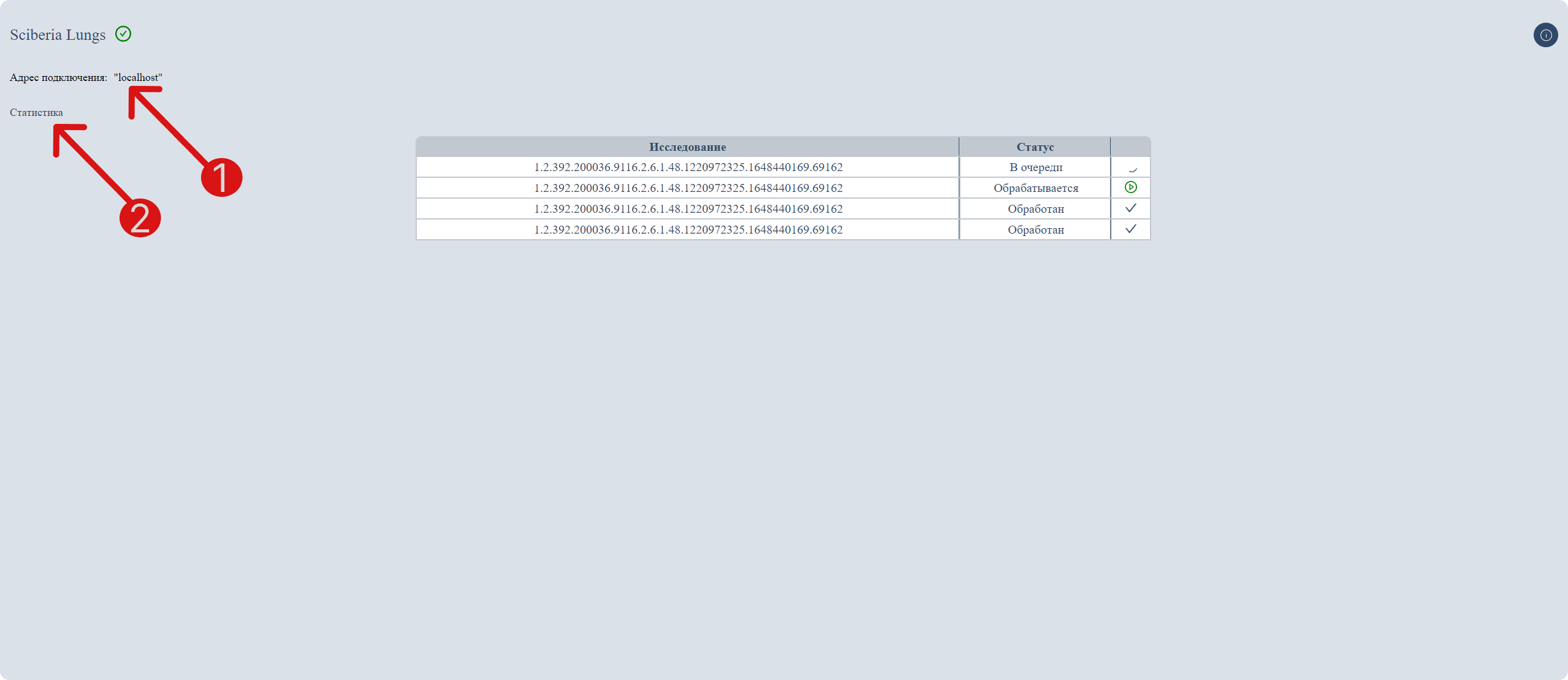
Displays the current connection Connection Address.
To open the module’s statistics window, click on the Statistics button.
Module Statistics Window:
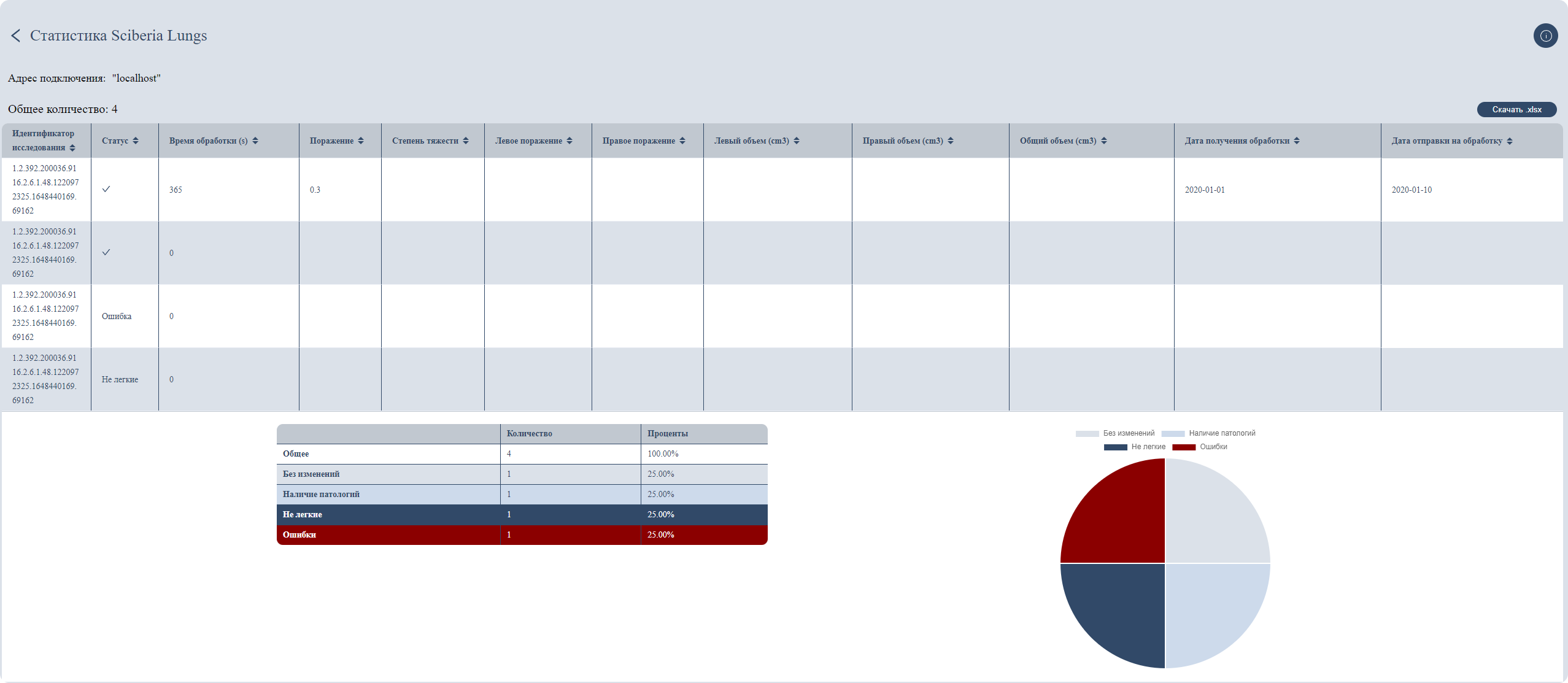
The table contains all studies that have been processed by the Sciberia Lungs module.
Total Number shows the total number of processed studies.
The table includes:
Column |
Description |
|---|---|
Study Identifier |
Identification number of the study. |
Status |
Status of the processed study. |
Processing Time |
Processing time of the study in seconds. |
Damage |
Overall percentage of lung damage. |
Severity Level |
Severity level of damage according to CT0-CT4. |
Left Lung Damage |
Percentage of damage to the left lung. |
Right Lung Damage |
Percentage of damage to the right lung. |
Left Lung Volume |
Volume of damage to the left lung in cm³. |
Right Lung Volume |
Volume of damage to the right lung in cm³. |
Total Volume |
Total volume of lung damage in cm³. |
Processing Date |
Date of receiving the processing. |
Submission Date |
Date of submission for processing. |
The status statistics of processed studies include a table (in quantitative and percentage terms) and a visualization in the form of a chart.
Field |
Description |
|---|---|
Total |
Total number of processed studies. |
Unchanged |
Number of studies with no changes. |
Presence of Pathologies |
Number of studies with pathologies. |
Not Lungs |
Number of studies without lung images. |
Errors |
Number of studies with initial errors. |
Note
Module monitoring is available only if the module is hosted on a medical organization’s server.
2.2. Access to the Module via API
Login and password for accessing the API where the module is located are provided by Sciberia.
2.2.1 Sending Studies for Processing with Sciberia Viewer
To send a study to the Sciberia Lungs processing module, select the desired study and click the «Send» button  .
.
Manual sending of studies for processing is available in the Sciberia Viewer program.
Important
Sciberia Viewer is software for viewing DICOM medical studies obtained from diagnostic equipment of various manufacturers. The software is available for an additional fee.
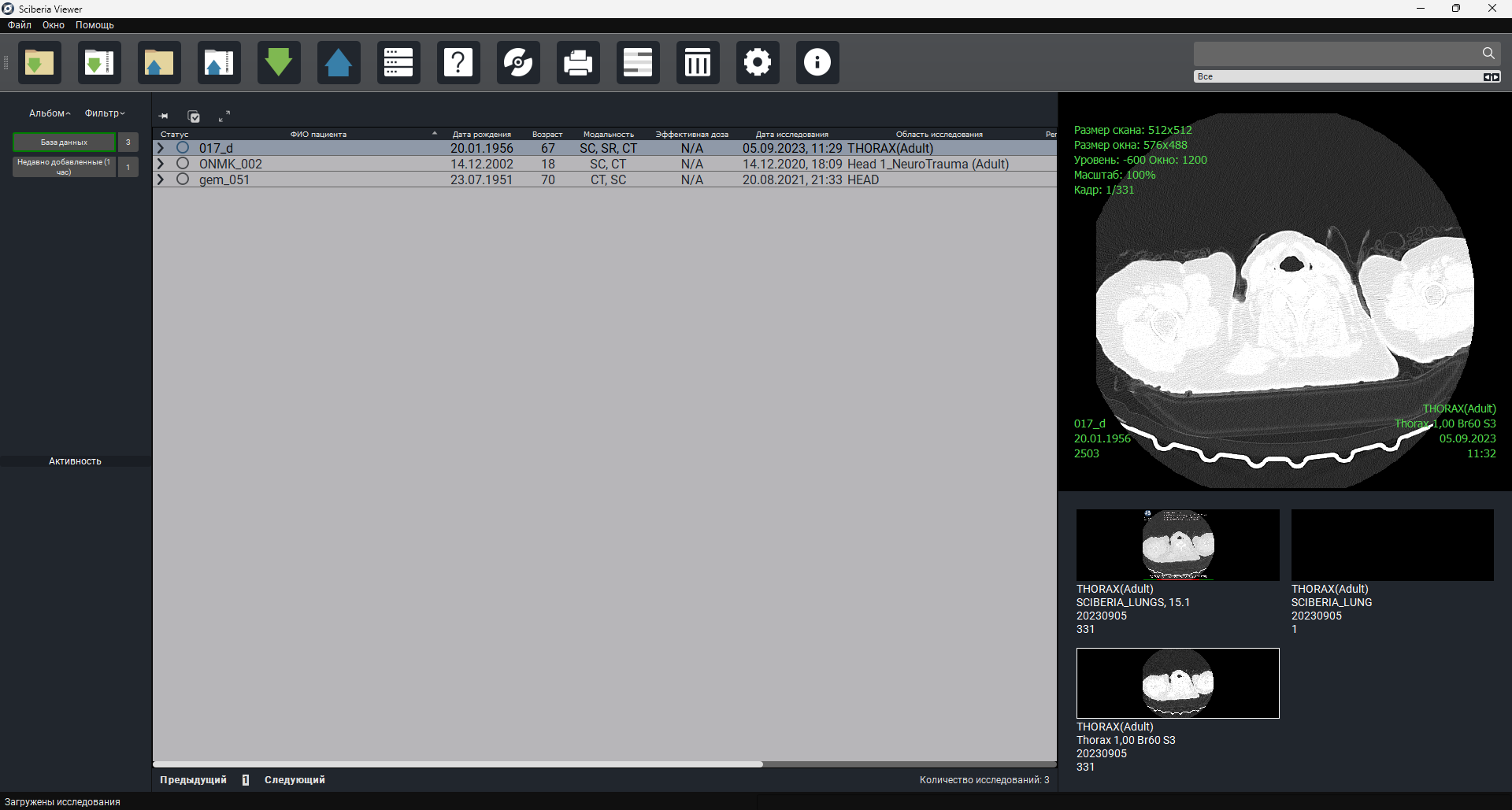
In the appearing window, select the required module for processing chest studies - «LUNGS».
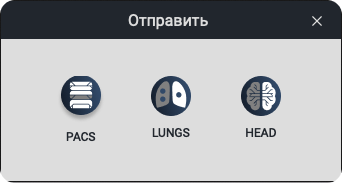
Clicking on «LUNGS» will open the following window:
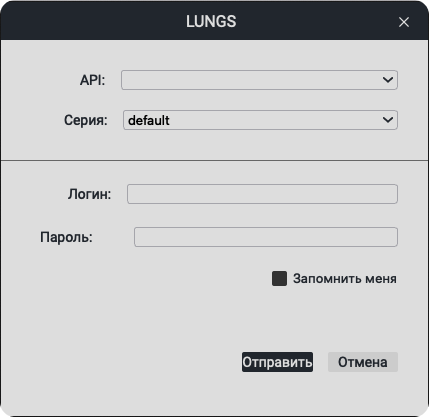
From the list, select the API and the required series, enter the API login and password. You can check the box for «Remember Me». Click the «Send» button.
Note
In Sciberia Viewer settings, you can configure the API connection parameters.
After processing, the same studies are presented with additional annotations and quantitative characteristics.
2.3. Processing Results
After processing, a copy of the original series with the modality «SC» (Secondary Capture) is created in the local storage.
Note
The processed results are sent back to the PACS server, from which users can view the results using any DICOM viewer.
If the software detects pathological patterns, the Secondary Capture image will contain the following information (marked with corresponding numbers):
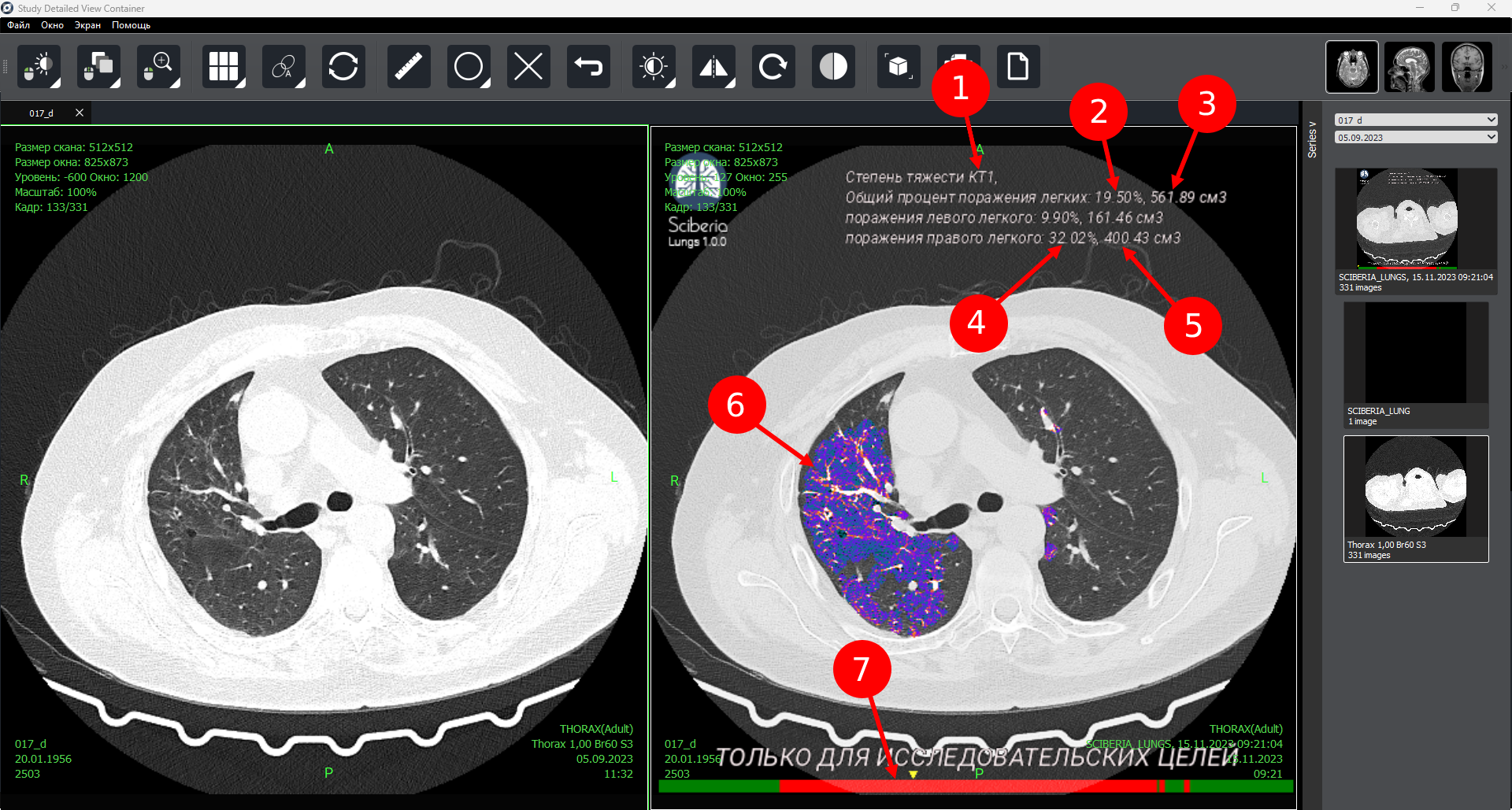
Number |
Description |
|---|---|
1 |
Severity level of lung damage (CT0 – CT4) determined by the module. |
2 |
Overall percentage of lung damage. |
3 |
Total volume of lung damage. |
4 |
Percentage of damage to the left and right lungs separately, calculated by the module. |
5 |
Volume of damage to the left and right lungs separately, calculated by the module. |
6 |
Areas of lung damage highlighted in color according to the DICOM standard spectrum. |
7 |
Slice area with detected pathology. |
If the module does not detect pathological patterns, the Secondary Capture image will contain the following information:
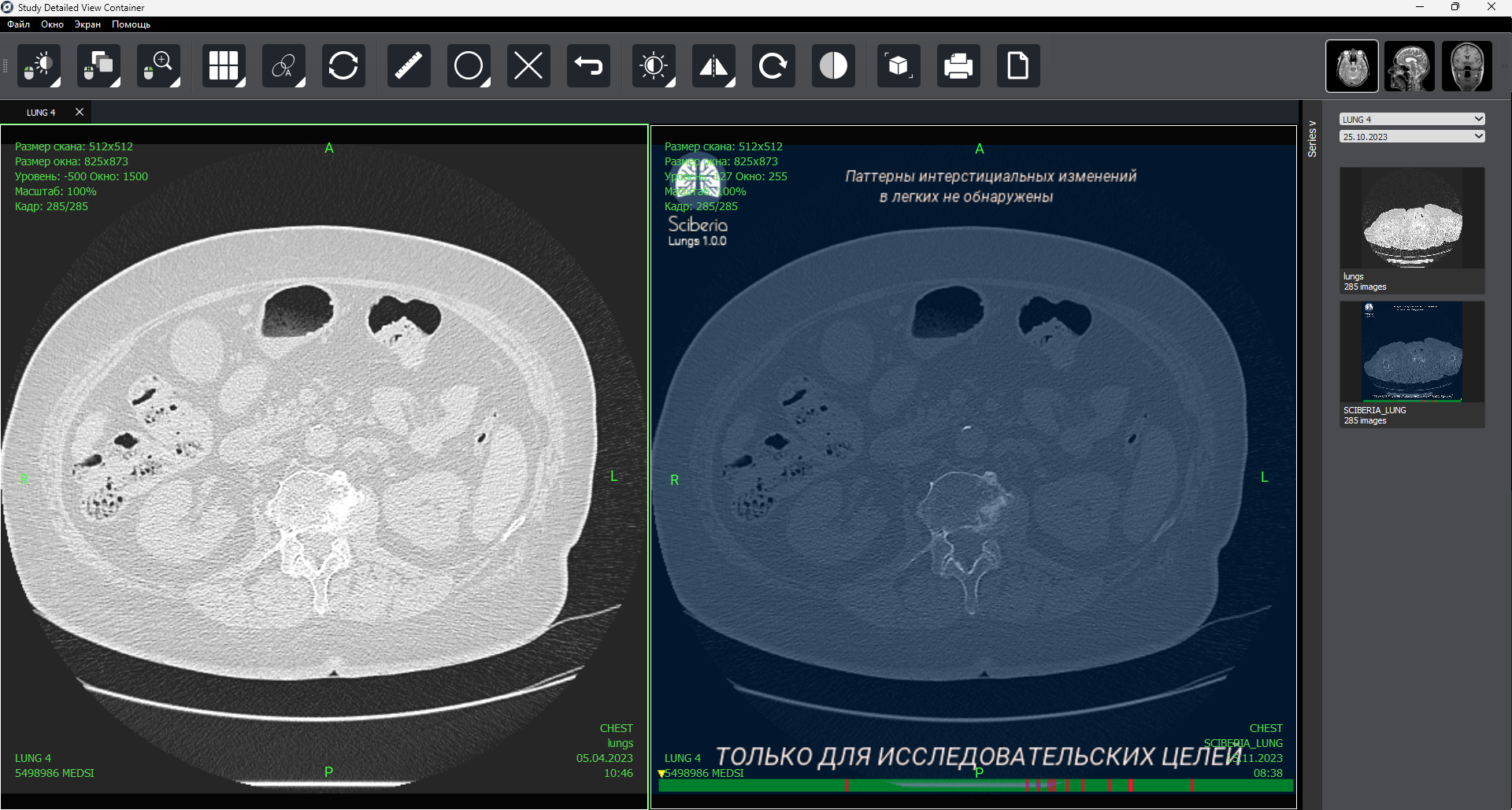
Important
All images in the new series will have a text message indicating that specialist interpretation is required: «For Research Purposes Only».
3. Module Shutdown
The module operates in a continuous, ‘background’ mode, so user operations to shut down the module are not provided. The module can only be interrupted by turning off the server on which it is installed, uninstalling it, or if it is disabled by the system administrator of the medical organization.